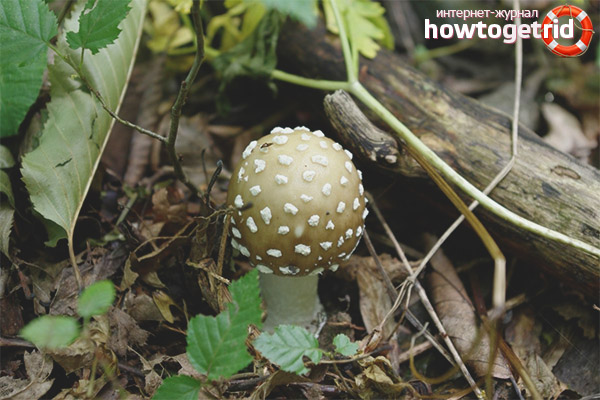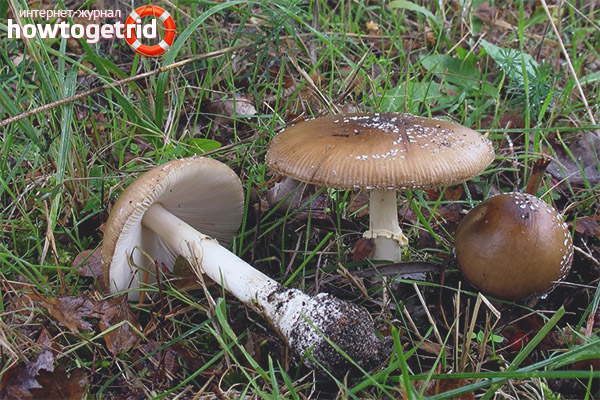The content of the article
Amanita panther is a mushroom belonging to the class of champignon mushrooms, the family of fly agaric. This fungus is characterized by toxicity and possession of hallucinogenic properties. In Latin, the name of the mushroom sounds like Amanita pantherina.
This genus was dubbed this name due to the fact that before these fungi were used to fight various insects. Including, carried out the fight against flies. This is where the somewhat unusual name came from.
It is not true to believe that this genus consists only of poisonous representatives. Of the total number of 6 species, it is represented by conditionally edible fungi.
External description
The leg of the mushroom is covered with a hat. It in the process of growth can acquire quite large sizes. In the process of growth, it can reach a diameter of 12 cm. At first, the cap is represented by a hemisphere, but then, as it grows, it becomes a flat area. Sometimes on the surface of the hat you can find flakes, which are the "remnants of the bedspread."
In nature, the first fly agarics can be seen when the ambient temperature reaches about 20 degrees Celsius. The fungus does not tolerate frost and likes to be in moist soil. A pronounced symbiosis of panther fly agaric with some trees (representatives of conifers) is observed. However, he will feel no less comfortable in a forest consisting of deciduous trees.
The hat has a brown color. It itself is smooth, with the presence of a large number of white flakes. If you try to separate them from the hat, that is not difficult to do. It is believed that fly agaric is associated with deadly toxicity. However, fatal poisoning is extremely rare.
Among all fly agarics, this species can be attributed to smaller brothers. Its appearance, unlike other representatives, is not so attractive. Therefore, very often, especially inexperienced mushroom pickers, it is mistaken for an edible mushroom. Especially often they confuse him when he is still small. Therefore, you must be extremely careful. In order not to make trouble for yourself, it is necessary to carefully study the external signs of panther fly agaric.
Among the variety of colors on the hat, the main shade is the olive color. This is due to the fact that it is often confused with edible mushrooms. A mushroom picker, poorly versed in all the intricacies, can take it for a boletus or a lump. If you cut the mushroom, the pulp will not change and will remain white. In this case, excessive wateryness is not felt.
The leg of the panther fly agaric can grow up to 12 cm. It does not differ in expressed massiveness, thin, with the presence of white pile on the surface. The leg has a low ring location or it is completely absent.
Amanita propagation is carried out using spores. It can be found in almost any forest. Find it among deciduous and coniferous trees. Very often it can be seen in a mixed forest. Often he finds a secluded place for himself under a pine or oak. Amanita grows well on soils with high alkalinity.
For its growth, weather with a temperate climate is preferable. He does not tolerate extreme heat and frost. Peak growth can be observed in mid-summer, and its end - in early autumn, in its first month.It is characteristic that in places where panther fly agaric is present, insects never occur. For them, its smell is destructive, so they prefer to be away from it.
What danger is this mushroom fraught with?
The danger of the fungus is due to two groups, which include toxic substances. The ingredients in the first group are identical to those that contain red mushroom. They are represented by muscarine, muscimol, ibotenic acid, bufotenin, serotonin, and other substances.
Substances of the second group are similar to those that contain black hen. In their combination, these substances cause poisoning in humans. It is characterized by a specific clinical picture, which even makes it possible to highlight the symptoms and combine them into a syndrome called panther poisoning.
The clinical picture of poisoning
The point of application of the active principle is the central parts of the nervous system. As a result of this, at first poisoning is accompanied by auditory and visual hallucinations. There are obvious changes in the behavior of the poisoned person. The severity of clinical symptoms depends on the dose of poison ingested. In urgent conditions, convulsions appear. A person loses consciousness and may fall into a coma.
The appearance of the first symptomatology is not long in coming. Sometimes 30 minutes is enough for this. In some cases, the time period is 5-6 hours, which depends on the amount of poison ingested. It should be said that poisoning with panther fly agaric is more difficult than in the case of red mushroom.
There are dyspeptic symptoms from the digestive tract in the form of vomiting, diarrhea. Tachycardia appears, breathing becomes faster. The temperature may rise. Quite often, a poisoned person hallucinates. Pupils expand, a state of euphoria occurs. In severe cases, increased psychomotor function. Muscles may involuntarily contract. It becomes painful for a patient to swallow, mucous membranes become dry.
First aid
The patient is subject to mandatory hospitalization. But before the ambulance arrives, he needs first aid. Similar events can be reduced to the following points:
It is necessary to carry out gastric lavage measures. For this purpose, a weakly concentrated solution of potassium permanganate or baking soda is used. Rinse the stomach very carefully. How long to rinse? Lavage is continued until clean rinsing water flows from the stomach.
The use of effective sorbents. An indispensable tool in this case is activated carbon. How much coal should be given to the patient? Reception is carried out at the rate of 1 tablet per 8-10 kg of body weight.
If the patient is concerned about severe pain, you can offer him to take antispasmodics, for example, no-shpu.
Until an ambulance arrives, the patient is watered with salted water. He must consume it in large quantities.
Hospitalization is required. Only within the walls of a medical institution can a patient be provided with qualified medical care. Atropine is commonly used as an antidote. Timely assistance is important. If this is not done, then even if the patient survives, poisoning can lead to serious complications. Encephalopathy or toxic hepatitis may develop.
The benefits of panther fly agaric
Oddly enough it sounds, but such mushrooms, it turns out, also have benefits. Certain types of fly agaric are used to make medicine. You can use them for certain business purposes:
- It has long been noticed that these representatives of the mushroom kingdom help get rid of insects. This feature, in fact, determined their name.
- The composition of the fly agaric contains a substance that is used to prepare drugs with antitumor activity.
- In ancient times, some nations used fly agaric to perform hallucinations when performing rituals and rituals.
- Legends say that panther fly agarics were consumed by warriors before joining the battle, because for the first time after using them they felt an incredible surge of fearlessness and aggression.
- Folk healers in their arsenal have recipes according to which tinctures and extracts are made from fly agaric. They are used to treat joint diseases.
- Modern pharmacy in its arsenal has tools that are prepared on the basis of fly agaric. They are used to relieve spasm of cerebral vessels and as an anti-sclerotic agent.
We distinguish edible mushrooms from inedible species
To avoid the troubles associated with poisoning, when collecting mushrooms, you must be extremely careful. Before picking mushrooms, you should carefully study the external structure of the panther fly agaric, as it can easily be confused with edible mushrooms. If it is good to know all the signs of this species of fly agaric, then confusing it with other mushrooms is quite difficult. The first thing that should push away from this fungus is its “screaming” appearance and a characteristic unpleasant odor. It is impossible that this mushroom even in a small fragment hit the table. Otherwise, acute severe poisoning simply cannot be avoided.
Video: Amanita pantherina (Amanita pantherina)












Submit